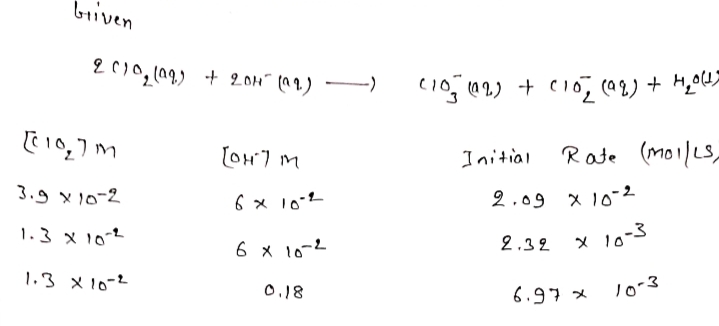Ih water. In basic solution it gives 103 and C102 ions. 2C102 (ag) + 20H (ag) → Cl03 (aq) + ClO2 (aq) + H2O(1) p obtain the rate law for this reaction, the following experiments were run and, for each, the nitial rate of reaction of CIO2 was determined. Initial Concentration Initial Concentration Initial Rate of Cl02 (mol/L) of OH (mol/L) (mol/(L-s)) Exp. 1 3.9 x 10-2 6.0 x 10-2 2.09 x 10- Exp. 2 1.3 x 10-2 6.0 x 10-2 2.32 x 10-3 Exp. 3 1.3 x 10-2 0.18 6.97 x 10-3
Ih water. In basic solution it gives 103 and C102 ions. 2C102 (ag) + 20H (ag) → Cl03 (aq) + ClO2 (aq) + H2O(1) p obtain the rate law for this reaction, the following experiments were run and, for each, the nitial rate of reaction of CIO2 was determined. Initial Concentration Initial Concentration Initial Rate of Cl02 (mol/L) of OH (mol/L) (mol/(L-s)) Exp. 1 3.9 x 10-2 6.0 x 10-2 2.09 x 10- Exp. 2 1.3 x 10-2 6.0 x 10-2 2.32 x 10-3 Exp. 3 1.3 x 10-2 0.18 6.97 x 10-3
Chemistry
10th Edition
ISBN:9781305957404
Author:Steven S. Zumdahl, Susan A. Zumdahl, Donald J. DeCoste
Publisher:Steven S. Zumdahl, Susan A. Zumdahl, Donald J. DeCoste
Chapter1: Chemical Foundations
Section: Chapter Questions
Problem 1RQ: Define and explain the differences between the following terms. a. law and theory b. theory and...
Related questions
Question

Transcribed Image Text:Chlorine dioxide, ClO2, is a reddish-yellow gas that is soluble in water. In basic solution it gives
Cl03 and C102 ions.
2C102 (aq) + 20H (aq) → C1O3 (aq) + ClO2 (aq) + H2O(1)
To obtain the rate law for this reaction, the following experiments were run and, for each, the
initial rate of reaction of C1O2 was determined.
Initial Concentration Initial Concentration Initial Rate
of Cl02 (mol/L)
of OH (mol/L)
(mol/(L·s))
Exp. 1
3.9 x 10-2
6.0 x 10-2
2.09 x 10-2
Exp. 2
1.3 x 10-2
6.0 × 10–2
2.32 x 10-3
Exp. 3
1.3 x 10-2
0.18
6.97 x 10-3

Transcribed Image Text:Obtain the value of the rate constant.
Rate constant =
L²/(mol² - s)
%3D
Expert Solution
Step 1

Step by step
Solved in 2 steps with 2 images

Knowledge Booster
Learn more about
Need a deep-dive on the concept behind this application? Look no further. Learn more about this topic, chemistry and related others by exploring similar questions and additional content below.Recommended textbooks for you

Chemistry
Chemistry
ISBN:
9781305957404
Author:
Steven S. Zumdahl, Susan A. Zumdahl, Donald J. DeCoste
Publisher:
Cengage Learning

Chemistry
Chemistry
ISBN:
9781259911156
Author:
Raymond Chang Dr., Jason Overby Professor
Publisher:
McGraw-Hill Education

Principles of Instrumental Analysis
Chemistry
ISBN:
9781305577213
Author:
Douglas A. Skoog, F. James Holler, Stanley R. Crouch
Publisher:
Cengage Learning

Chemistry
Chemistry
ISBN:
9781305957404
Author:
Steven S. Zumdahl, Susan A. Zumdahl, Donald J. DeCoste
Publisher:
Cengage Learning

Chemistry
Chemistry
ISBN:
9781259911156
Author:
Raymond Chang Dr., Jason Overby Professor
Publisher:
McGraw-Hill Education

Principles of Instrumental Analysis
Chemistry
ISBN:
9781305577213
Author:
Douglas A. Skoog, F. James Holler, Stanley R. Crouch
Publisher:
Cengage Learning

Organic Chemistry
Chemistry
ISBN:
9780078021558
Author:
Janice Gorzynski Smith Dr.
Publisher:
McGraw-Hill Education

Chemistry: Principles and Reactions
Chemistry
ISBN:
9781305079373
Author:
William L. Masterton, Cecile N. Hurley
Publisher:
Cengage Learning

Elementary Principles of Chemical Processes, Bind…
Chemistry
ISBN:
9781118431221
Author:
Richard M. Felder, Ronald W. Rousseau, Lisa G. Bullard
Publisher:
WILEY